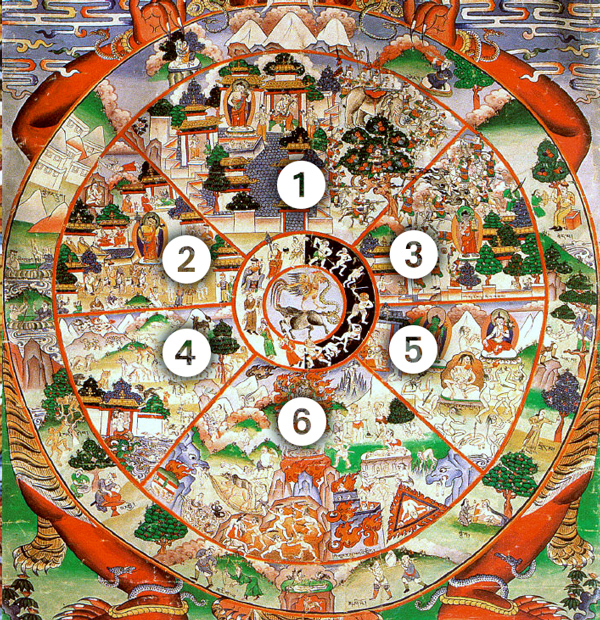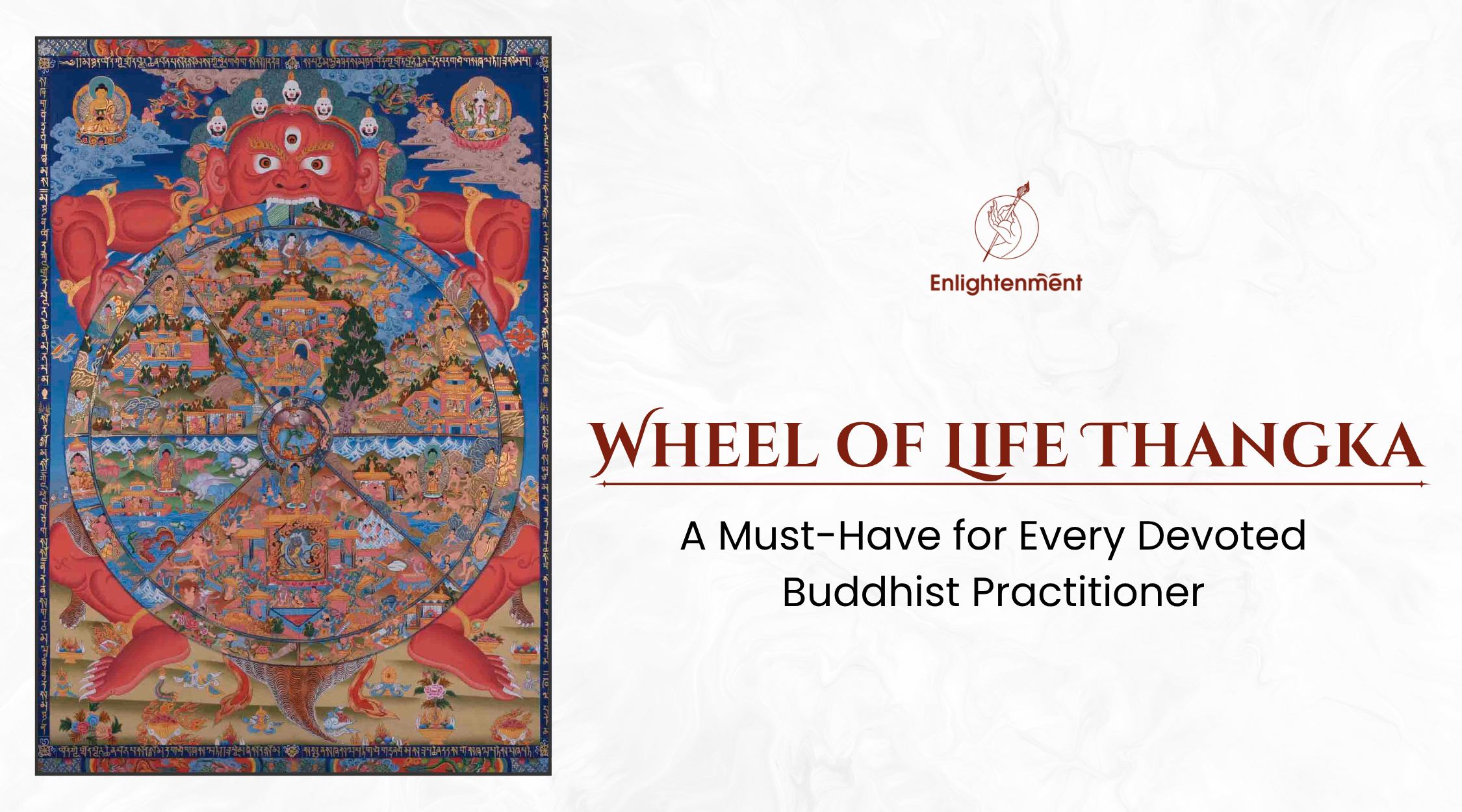Yama, the lord of Death holds the Wheel of Life
The Wheel of Life Thangka, or Bhavacakra, is a sacred artistic depiction and one of the most profound visual teachings in all of Buddhism. Rich in symbolism, this intricate diagram vividly illustrates the cycle of samsara—birth, death, and rebirth—and offers a powerful lens into the causes of suffering, the law of karma, and the path to liberation.
The Bhavacakra thanka is a venerated, living embodiment of the teachings that capture the essence of the journey toward enlightenment, intricately woven into every detail of this mandala of existence. Whether you're just starting out or have been on this path for a while, this thanka is a must-have. It is not just a beautiful decoration for your altar; this vibrant and powerful image acts as both a spiritual tool and a meditation aid, making it vital for anyone devoted to Vajrayana practice. In this read, dive into why this esteemed thangka is so significant in the Vajrayana tradition.
Understanding the Profound Significance of the Wheel of Life Thangka

The Bhavacakra, intricately illustrated in the Wheel of Life Thangka, is a dynamic map of the Buddhist path—illustrating both the entrapment in samsara and the liberation at hand through realization. Every symbol and section holds a deep, multi-layered meaning that touches the heart of Vajrayana practice, where wisdom, compassion, and skillful means converge.
1. The Three Poisons—Ignorance, Hatred, and Desire

At the heart of the thanka, the three animals—the pig, snake, and rooster—symbolizes the three poisons (Tibetan: kleshas) that are the root causes of all our delusions and suffering. As Vajrayana practitioners, we recognize that these poisons are not just abstract concepts; they are deeply connected to our ego and self-attachment. Instead of pushing them away, the vajra path of transformation encourages us to face these poisons head-on, cultivating the wisdom that helps us cut through them.
- Ignorance (pig): At the very center of samsara, ignorance isn't just a lack of knowledge; it's a fundamental misunderstanding of the true nature of emptiness. Practices like Lojong and Dzogchen directly address this core affliction.
- Hatred (snake): The snake represents the destructive power of attachment and aversion. In Vajrayana, this compassionate perspective transforms these feelings into the path of Mahamudra, where our emotions can evolve into wisdom.
- Desire (rooster): The rooster symbolizes the endless craving that keeps us trapped in the cycle of birth and rebirth. Through visualization techniques and mantra-based meditations in Vajrayana, we can turn this desire into the driving force behind compassionate action.
2. The Six Realms of Samsara

The six realms in the thangka—depicting gods, demigods, humans, animals, hungry ghosts, and hell beings—represent the broad spectrum of experience in samsara, each one echoing the five poisons and the mental states tied to them.
For Vajrayana practitioners, each realm offers a rich tapestry of insight, guiding reflection on the states of mind to transcend:
- God Realm
- Demi God Realm
- Animals Realm
- Hell Realm
- Hungry Ghost Realm
- Human Realm
-
Gods and Demigods: While they may appear to be in a state of bliss, the gods actually embody the illusion of permanence, while the demigods reflect our attachment to power. By engaging in vajra recitations and showing devotion to the guru, we come to understand the reality of impermanence, which ultimately exposes the dissatisfaction that lingers even in the most elevated states.
-
Animals, Hungry Ghosts, and Hell Beings: These realms represent the spiritual struggles that keep sentient beings trapped in suffering. For someone practicing Vajrayana, engaging with these elements means transforming negative karma through rituals, purification practices, and chanting mantras like
"Om Mani Padme Hum." - Humans: This realm offers a special chance for awakening, where both suffering and joy serve as catalysts for our realization. In Vajrayana, we view this as the perfect foundation for self-liberation through Tantric practices.
3. The Twelve Links of Dependent Origination
The outer circle of the thangka illustrates the twelve links of dependent origination, highlighting the profound connection between cause and effect. Grasping this cycle is essential to the advanced teachings of Vajrayana, where the concepts of emptiness and interdependence are experienced through direct perception and transmission.
These links show us how ignorance (avidya) leads to karmic formations (samskara), which then give rise to consciousness (vijnana), name and form (nama-rupa), and continue on to the cycle of rebirth. For Vajrayana practitioners, the teachings on these twelve links serve as a gateway to direct experience—where deep meditations on impermanence can help one cut through the very root of samsara.
Refer to the following section for a closer look on these 12 links of Dependent Origination:
- Ignorance (Avidyā) – Not understanding the Four Noble Truths; the root of all suffering.
- Volitional Formations (Saṅkhāra) – Mental formations or karmic actions created by ignorance.
- Consciousness (Vijñāna) – The arising of awareness that connects one life to the next.
- Name and Form (Nāma-rūpa) – The mind-and-body complex that constitutes a sentient being.
- Six Sense Bases (Ṣaḷāyatana) – The six faculties: eye, ear, nose, tongue, body, and mind.
- Contact (Sparśa) – The meeting of sense organ, sense object, and consciousness.
- Feeling (Vedanā) – Pleasant, unpleasant, or neutral sensations that arise from contact.
- Craving (Tṛṣṇā) – Desire for pleasure and aversion to pain; attachment to experience.
- Clinging (Upādāna) – Grasping onto desires, views, rituals, and a sense of self.
- Becoming (Bhava) – The karmic process that leads to the formation of a new life.
- Birth (Jāti) – The arising of a new existence or rebirth in samsara.
- Aging and Death (Jarāmaraṇa) – The inevitable decline and dissolution of the body and mind.
4. The Buddha’s Liberation
Above the Wheel of Life, we see the Buddha pointing toward the moon—a gesture rich with meaning. The moon symbolizes nirvana—the end of suffering, the conclusion of the samsara cycle, and the discovery of ultimate truth. By directing our attention to it, the Buddha is reminding us that liberation is within reach, no matter where we find ourselves on the wheel.
In Vajrayana Buddhism, this gesture carries even more significance. The moon stands for emptiness (śūnyatā)—the true essence of all things, untainted by inherent existence. Achieving a direct understanding of emptiness is seen as the pinnacle of wisdom, leading to a non-dual awareness where the lines between subject and object blur, allowing the practitioner to dwell in a radiant clarity that transcends ordinary thought.
With the guidance of a realized guru and through Tantric rituals and practices, practitioners can come to see that liberation isn’t just a far-off dream; it’s a vibrant reality available to us right now. By engaging in practices like deity yoga, mantra recitation, and devotion to the guru, even the simplest moments of our lives can become stepping stones on the path to awakening. So, when the Buddha points to the moon, it’s a powerful reminder of our true potential—to break free from the illusions of samsara and tap into the timeless, expansive awareness that already resides within us.
Why the Wheel of Life Thangka is Vital for Vajrayana Practitioners
With its rich symbolism and intricate details, the Bhavacakra thangka reflects a practitioner's mind, helping them navigate the stages of realization and awakening. In the following sections, we’ll delve into why this thanka is a must-have for anyone serious about their Vajrayana practice.
1. A Transformative Meditation Tool
For those practicing Vajrayana, the anatomy of Wheel of Life thangka is not just something to look at; it is a dynamic tool for personal transformation. Each meditation session kicks off with a deep gaze into the thangka, allowing the essence of interdependence, impermanence, and wisdom to flow in. The detailed symbolism encourages practitioners to visualize the deities, realms, and poisons, transforming them through the power of mantras and visualization techniques. By meditating on the three poisons, the realms of existence, and the twelve links, practitioners tap into their inner energies, engaging with the path of vajra purification, where mental obstacles are cleared away.
2. A Deep Teaching for the Vajrayana Path
In the realm of Vajrayana Buddhism, the Wheel of Life thanka is often paired with esoteric teachings. It serves as a gateway to deeper understanding, where the images and symbols lead practitioners into the heart of Lojong (mind training), Mahamudra, and tantric methods. This thanka acts as a sacred map, aligning teachings with the stages of tantric realization, guiding individuals from sutra teachings to the more profound practices of Vajrayana, making complex philosophical ideas accessible and ripe for transformation.
3. A Sacred Reminder of Impermanence
For those on the Vajrayana path, every glance at the Wheel of Life thanka serves as a potent reminder of the impermanent nature of all things. By reflecting on the fluid and interconnected essence of existence, practitioners embody the Vajrayana spirit of non-attachment. This ongoing awareness of the transient nature of samsara reshapes their relationship with material and emotional ties, fostering a state of non-grasping.
4. Direct Path to Liberation
With the Buddha’s gesture pointing to the moon in the thangka, practitioners are shown a direct route to liberation. This isn’t some far-off dream; it’s a possibility right here and now. Through the Tantric practices of Vajrayana—mantras, visualizations, and direct teachings from the lama—the path to liberation becomes clear and attainable.
Why Choose a Wheel of Life Thangka from Enlightenment Thangka

At Enlightenment Thangka, we offer a meticulously curated collection of authentic Wheel of Life thankas crafted by skilled artisans in Nepal using traditional methods and materials. Here's why our thankas are a unique addition to your Vajrayana practice:
1. Authentic Vajrayana Craftsmanship
Our thangkas are hand-painted by highly skilled artisans, using organic cotton or silk, and natural pigments that align with traditional Vajrayana standards. This ensures that every piece is not only a visual representation but a sacred art infused with the intention to support your spiritual journey.
2. Diverse Collection of Authentic Thangkas
Alongside our own exceptional creations, we take great pride in showcasing the works of other skilled artisans who have truly mastered the art of traditional thanka painting. Each piece in our collection beautifully embodies the principles of Vajrayana and is thoughtfully selected for its artistic quality and spiritual richness.
3. Variety of Artistic Styles and Approaches
Our collection boasts a diverse array of styles—everything from timeless designs steeped in tradition to fresh, modern interpretations. This variety gives practitioners the freedom to choose a thanka that truly resonates with their personal journey. Whether you’re drawn to the delicate brushwork of a classic scroll painting or the daring creativity of contemporary art, you’ll find something in our collection that perfectly aligns with your spiritual aesthetic.
Embark on the Path to Liberation
The Wheel of Life Thangka is an essential guide for anyone practicing Vajrayana Buddhism, offering deep insights into suffering and the journey toward liberation. It’s not just a beautiful image; it captures the core of Buddhist teachings, helping practitioners navigate the Tantric path—from facing the three poisons of ignorance, hatred, and desire to understanding the profound truth of emptiness and ultimately reaching nirvana.
With its rich symbolism, the tangka acts as both a visual and spiritual guide, encouraging practitioners to contemplate the interconnectedness of all things and the fleeting nature of samsara. It serves as a constant source of inspiration, urging them to deepen their practice, tackle challenges, and stay committed to their quest for enlightenment. More than just a piece of art, the Wheel of Life Thangka is a dynamic tool for transformation. It empowers and uplifts practitioners, providing clarity and strength as they navigate the ups and downs of their spiritual path. Each time they gaze upon this Tibetan painting, they take another step toward breaking free from the cycle of suffering and discovering the liberation that is so close at hand.
Explore more of our curated collection of Wheel of Life Thangka here where each thanka is will be an essential part of your Vajrayana journey toward enlightenment.


